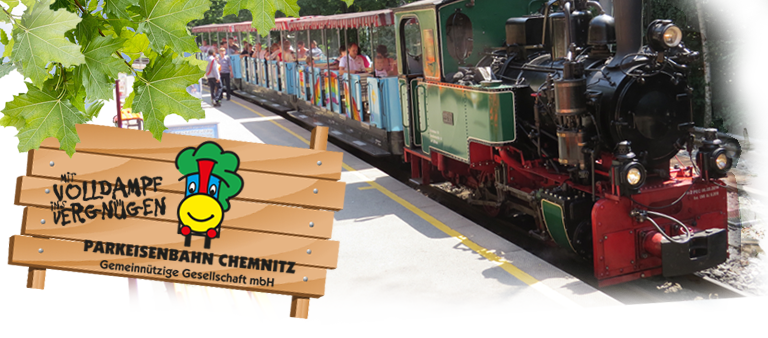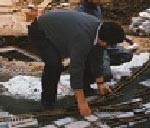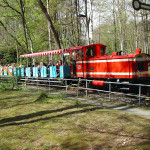 In the romantic Küchwald Park in the middle of the Saxonian city of Chemnitz, railway lovers can find the object of their affections and discover among other things 1 steam, 1 accumulator battery and 3 diesel locomotives as well as 7 wagons and 1 handcar.
In the romantic Küchwald Park in the middle of the Saxonian city of Chemnitz, railway lovers can find the object of their affections and discover among other things 1 steam, 1 accumulator battery and 3 diesel locomotives as well as 7 wagons and 1 handcar.
The Chemnitz Park railway was founded as a non-profit venture and is still living from the caring engagement of many railroad lovers. Since 1954 the venture has operated on a 2.3 km long circular layout that possesses one railway station and two flag stops.
About 100,000 visitors join the attraction on tracks every year from March to October. The modern engine shed offers beside the locomotive and wagon hall also function rooms, a café and a 200 m² big garden railway in the courtyard.
Throughout the year a big variety of events takes place like the mascot get-together, the Santa Claus surprises or the balloon festival. Particularly loved is the annual engine shed festival where all vehicles of the Chemnitz Park railway are shown.
Chronic of the park railway
On the 1 April 1985 the city of Chemnitz bought the Küchwald park at the price of 460,000 Mark. Since 1988 the Küchwald park has been changed into a forest park. In 1900 the today’s path system was created and the fairground was expanded to the today’s dimension. Up to 1909 the restaurant “Küchwaldschänke” (today the open air theater) was built. At the end of the Second World War bombs had destroyed the popular destination of Chemnitz.
Firstly in 1952 the city council assembly of Chemnitz decided to change the Küchwald park into a cultural park. This plan also included the building of a pioneer railway. The train should drive along the “Küchwaldring”.
At the Leipziger Straße and the today’s youth hostel should exist 2 terminal loops. Altogether they had planned 3 flag stops. The gauge of the track should originally be 381 mm but the necessary material wasn’t available so that they had to change the trains into light railway and the gauge of the track into 600 mm.
On the 14 March the construction of the 2.3 km long track started. They planned to hand over the pioneer railway on the 1 Mai 1953. The locomotives and the wagons could be completed after 2000 hours of work on time and could be presented to the public on the 1 Mai 1953.
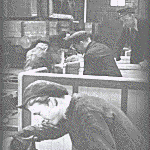 An interesting picture of the 50’s.
An interesting picture of the 50’s.
In a production hall in Chemnitz open passenger wagons were constructed.
You can also see the first light railway diesel locomotive No. 6001, year of construction 1934, type series 7 L 105, 22 PS, constructor: Fa. Arnold Jung
Karlheinz Krupka (in the foreground) was there.
On the 21 April 1953 the newspaper “Volksstimme” could only give an account of 270 m track. In July they could report on the finishing of 540 m. The track was finished from the “Tennisplätze” to the “Schafstreibeweg”. Problems with the material and mistakes during the planning caused a deadline shift. Because of the direction of the track – that still exists today – the railway station on the Leipziger Straße couldn’t be built.
Because in July 1953 the engine shed and further 500 m track could be finished the tram could shuttle on 1000 m track during the festival on the Schlossteich on the 1 August 1953. Until the opening 12,000 m³ ground were moved and 16,000 working hours were done.
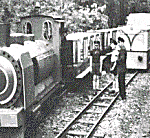
The first locomotive that was used was a light railway diesel locomotive with 22 PS that was built in 1934. The locomotive was bought from the company Paul Keller in Chemnitz for 3,000 DM on the 28 April 1953. Externally the locomotive was redesigned to a steam locomotive. It had a mechanical hand brake and a net weight of 5.5 tons. The fastest speed of the locomotive was 8 km/h. The open passenger wagons offered space for 24 guests.
A light railway was externally redesigned so that it looked like a steam locomotive.
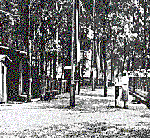
Since the 1 April 1954 the work on the park railway had continued. The finishing of the whole track was planned for the 1 June 1954. But this date also couldn’t be realized. Just with the hard work of the railroaders and 5,000 working hours from the 24 Mai to the day of the opening the track of 2.3 km length could be handed over in June. Since the 4 June 1954 the transport companies are owner of the railroad.
The former railway station of the children’s railroad, in 1980 it was substituted by the current one.
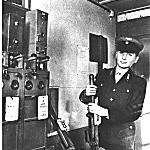
In 1966 a petrol station with the quantity of 4,000 liter fuel could be absorbed. At the beginning of the 70’s the academy of transportation Dresden did researches on possibilities to equip all the pioneer railways of the DDR the same. But it wasn’t ever realized. In 1973 electrical light signals were installed at the railway station. The locomotives of 1975 and 3 passenger wagons were equipped with air brakes. In 1980 the new station building was inaugurated and one year later the park railway was donated a diesel locomotive by the brick factory Hainichen. Until 1990 just a few of the projects they had planned could be realized. The reunion of the two German states brought some new things for the park railway. Especially the foundation of the development association “Parkeisenbahn Küchwald” could achieve a lot.
The room of the station inspector from 1954 to 1980.
Today the in 1990 founded restaurant “Bahnsteigklause” is conducted altruistically by the development association. In 1992 the new flag stop “Tennisplätze” was built by the members of the development association. The new installed safety technology made double journeys possible. A colorful program increases the attractiveness of the park railway.
Especially we have to point out the many sponsors, companie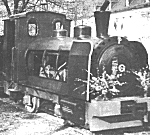 s and private persons that have supported the park railway in a financial way. The best example for this is the new covered wagon.
s and private persons that have supported the park railway in a financial way. The best example for this is the new covered wagon.
Opening of the driving season in the 50’s.
The more than 170 members of the developing association “Parkeisenbahn Küchwald” will also do their best in the future that a journey with the park railway will be a staying happening for young and old.
Garden railway
In the romantic Küchwald Park in the middle of the Saxonian city of Chemnitz, railroad lovers can find the object of their affections in two scales.
Since 1954, Chemnitz park railway has operated on a 2.3-kilometer circular layout on 600 mm track from March to October. The pioneers of the railway society originally began this undertaking as a nonprofit venture, and they continue to this day in their efforts to charm park visitors, young and old alike.
More recent history was written at the end of the 90s. In 1997, one of the most modern engine sheds of Europe in narrow gauge railway size was established on the park railway. Beside the new building of the locomotive and rolling stock shed, there was also a provision for a conference and meeting area as well as a café. This new building complex is arranged around a large inner court.
During the course of the construction of these new buildings, a question was raised: “How could the inner courtyard of the engine shed can be made more meaningful and interesting?” It didn’t take long for the idea to be proposed. Soon it was confirmed – a garden railway was to be developed!
Park railroad fans, former railroad employees and model railroad buffs all came together in the planning, and in the late summer of 1997 the garden railway construction began. At the time, the goal was to have at least one circle of track operational for the opening of the engine shed in late 1997.
This was an ambitious project, for only two months remained until the grand opening and the members had quite a bit of preparation work in the courtyard before the first piece of track could be laid.
Finally, on October 31,1997, the garden railway was ready to run. The garden railway was opened at the same time as the ceremonial opening of the engine shed by Chemnitz mayor Dr. Peter Seifert – in fact, the mayor “drove” the first engine over the line!
The unveiling of the garden railway brought in so many donations that intensive construction continued during the late autumn that year. During this time, the gartenbahner not only worked after their jobs each weekday, but also on the weekends – to the tune of more than 4000 man-hours!
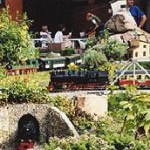 All the landscaping on the layout is a result of direct donation or was purchased with the cash contribution to the layout. All locomotives and cars are gifts-in-kind from individuals, families and companies. On certain days, LGB fans can bring along their own trains to run on the layout. Donations are still solicited and the layout – as is the case for most private LGB layouts – is never finished!
All the landscaping on the layout is a result of direct donation or was purchased with the cash contribution to the layout. All locomotives and cars are gifts-in-kind from individuals, families and companies. On certain days, LGB fans can bring along their own trains to run on the layout. Donations are still solicited and the layout – as is the case for most private LGB layouts – is never finished!
